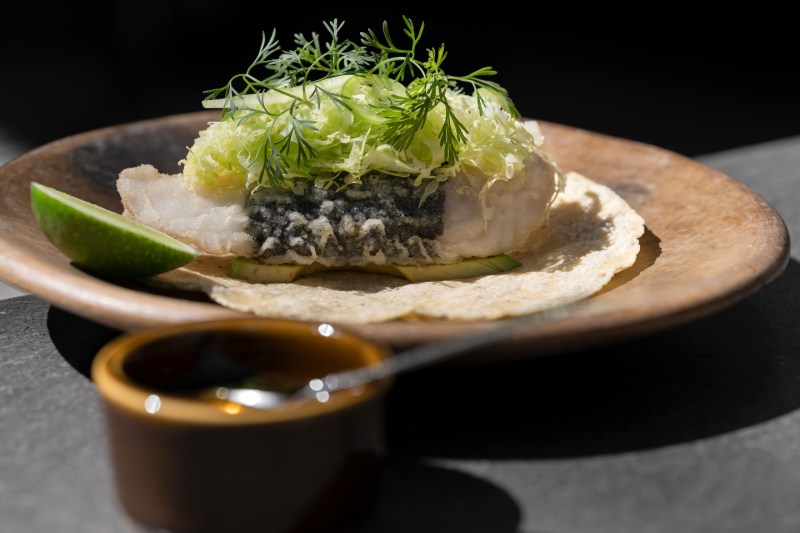Fall stands for a lot of things, from foliage and darker beers to comfort food and sweaters. It also stands for a different kind of taco, one that fully embraces the bountiful season. After all, there’s no bad time of the year for the taco, but some are more seasonally appropriate than others.
We reached out to chef Jesus “Chuy” Cervantes of Damian. He’s the chef de cuisine at the Los Angeles restaurant and offered an outstanding fall-inspired recipe for fish tacos. That’s right, fish tacos. They’re not just for the dog days of summer, people. Born on the beach, they can be tweaked for the offseason as well, and in creative, decidedly delicious ways.
The fall-ness is in the details. The recipe calls for some genuinely earthy colors, afforded by unique additions like nori. The ponzy adds a tart and sweet element that functions a bit like a vinaigrette and really ties everything together. The cabbage adds a nice touch and is about to be in peak-season throughout most of the U.S. The resulting tacos will comfort, which is what fall is all about, while hinting at the brighter seasons you long for this time of year with the summer accents offered by chiles and cilantro.
The ultimate fusion tacos, this recipe blends Japanese and Mexican cuisines. We love it on its own but it’s also great with a light beer or bright wine like Sauvignon Blanc or Chenin Blanc. Shoot, mix up a tequila drink and give it the autumn treatment.
Don’t have bass? Try grouper, mahi-mahi, red snapper, or even tilapia. Oh, and put some effort into your sauce selection. “Go to your local Japanese market and ask for a nice artisanal soy sauce or ponzu, it will make all the difference in seasoning your tempura,” Cervantes says of the dish, below.
Fall Fish Tempura Tacos

This is a recipe that will quickly become one of your favorites when making tacos. As a fine restaurant worker, chef Cervantes has some plating advice as well. And because we’re dealing with tacos, there’s an order to the building process. He suggests placing the tortillas on a warm plate, with a slice of avocado on each. Top the avocado with a piece of fried fish and then garnish it with cabbage, chiles, and cilantro. Serve them up with lime and some ponzu sauce. Still hungry? Cap it off with a nice fall dessert idea.
Prep time: 15 min
Total time: 25 min
Yield: 4 tacos
Ingredients
- 240 grams clean striped bass or similar fish
- 2 sheets of nori
- 1 ½ cups rice flour
- 2 cups soda water
- ¼ head of cabbage
- 1/2 avocado
- 1 serrano chile
- ¼ bunch of cilantro
- 2 limes
- Salt to taste
- 4 tortillas
- Soy sauce or ponzu as needed
- 2 liters frying oil
Method
- Pre-heat the frying oil in a deep pot to 350 degreed Fahrenheit.
- Prepare the fish by cutting the loin into 60-gram strips.
- Prepare the nori by splitting the two sheets in half.
- Layout each nori sheet separately, brush lightly with water, then lay each piece of fish in a sheet of nori. Roll the fish over until wrapped all the way around and cut away any excess. Reserve the fish.
- Prepare the tempura batter by whisking together 1 cup of rice flour and 2 cups of soda water.
- Use the remaining ½ cup of rice flour to lightly dredge the fish prior to dipping in batter.
- Prepare the garnishes by thinly slicing the cabbage and serrano chiles, picking the leaves of cilantro and slicing the lime into wedges.
- Prep the avocado by slicing into 4 even-sized slices, reserve until plating.
- Dip the prepped fish in the batter, coat completely and slowly drop into the hot oil.
- Allow the fish to fry until you’ve accomplished a light golden color. About 2 minutes.
- Once ready, remove the fish from the oil, season with salt and rest on dry paper towels to allow the excess oil to drain.
- Prepare the tortillas by heating on a flat griddle or large pan. Reserve warm in a tea towel.


